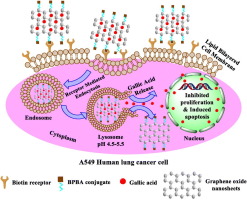Biomaterials Advances ( IF 7.9 ) Pub Date : 2020-03-26 , DOI: 10.1016/j.msec.2020.110884 Nitin Gupta 1 , Stuti Bhagat 2 , Mandeep Singh 3 , Ashok Kumar Jangid 1 , Vipul Bansal 3 , Sanjay Singh 2 , Deep Pooja 4 , Hitesh Kulhari 1

|
Chemotherapy has remained one of the most commonly employed treatment modalities for cancer. Despite the clinical availability of a large number of chemotherapeutic agents, the uncontrolled systemic distribution and the associated harmful side effects of chemotherapeutic agents pose major challenges demanding concerted efforts to enhance their cancer targetability. The layered structure of two-dimensional (2D) materials offers new opportunities by increasing the drug pay-load influencing the drug-release kinetics in a cancer micro-environment and facilitating targetability through the large accessible surface area. To investigate such potential benefits of 2D materials, we have developed a biocompatible targeted 2D drug delivery system using graphene oxide (GO) as a model nanocarrier (NC) that could hold a high concentration of gallic acid (GA), a natural chemotherapeutic agent found in green tea. Interestingly, the antioxidant nature of GA also reduced GO to a high-quality few-layered thin reduced-graphene oxide (rGO) during drug loading while forming rGO nanocarrier (rGONC). The biotinylated rGONC further improved their targetability to A549 human lung carcinoma cells and they enhanced cellular internalization efficiency. From these targeted 2D NCs, the drug could release only slowly at the physiological pH but liberated rapidly at lower pH encountered by the tumor microenvironment resulting in significant toxicity toward the lung carcinoma cells. As such, this work opens up new possibilities for employing 2D materials for targeted chemotherapeutic applications.
中文翻译:

使用生物素化的二维rGO纳米载体将天然化学治疗剂向人肺癌细胞的位点特异性递送。
化学疗法仍然是最常用的癌症治疗方法之一。尽管临床上可获得大量化学治疗剂,但是化学治疗剂的不受控制的全身分布和相关的有害副作用带来了重大挑战,需要共同努力以增强其癌症靶向性。二维(2D)材料的分层结构通过增加影响癌症微环境中药物释放动力学的药物有效载荷并通过较大的可及表面积促进靶向性而提供了新的机会。为了研究2D材料的这种潜在益处,我们开发了一种生物相容的靶向2D药物递送系统,该系统使用氧化石墨烯(GO)作为模型纳米载体(NC),可以容纳高浓度的没食子酸(GA),绿茶中发现的一种天然化学治疗剂。有趣的是,GA的抗氧化性质也将GO还原为高质量的几层稀薄的氧化石墨烯氧化物(ř GO)的载药量,同时形成期间ř GO纳米载体(ř根茨)。生物素化的r GONC进一步提高了其对A549人肺癌细胞的靶向性,并提高了细胞内在化效率。从这些靶向的2D NC中,该药物只能在生理pH值下缓慢释放,而在肿瘤微环境遇到的较低pH值下迅速释放,从而导致对肺癌细胞的显着毒性。这样,这项工作为将2D材料用于目标化学治疗应用开辟了新的可能性。



























 京公网安备 11010802027423号
京公网安备 11010802027423号